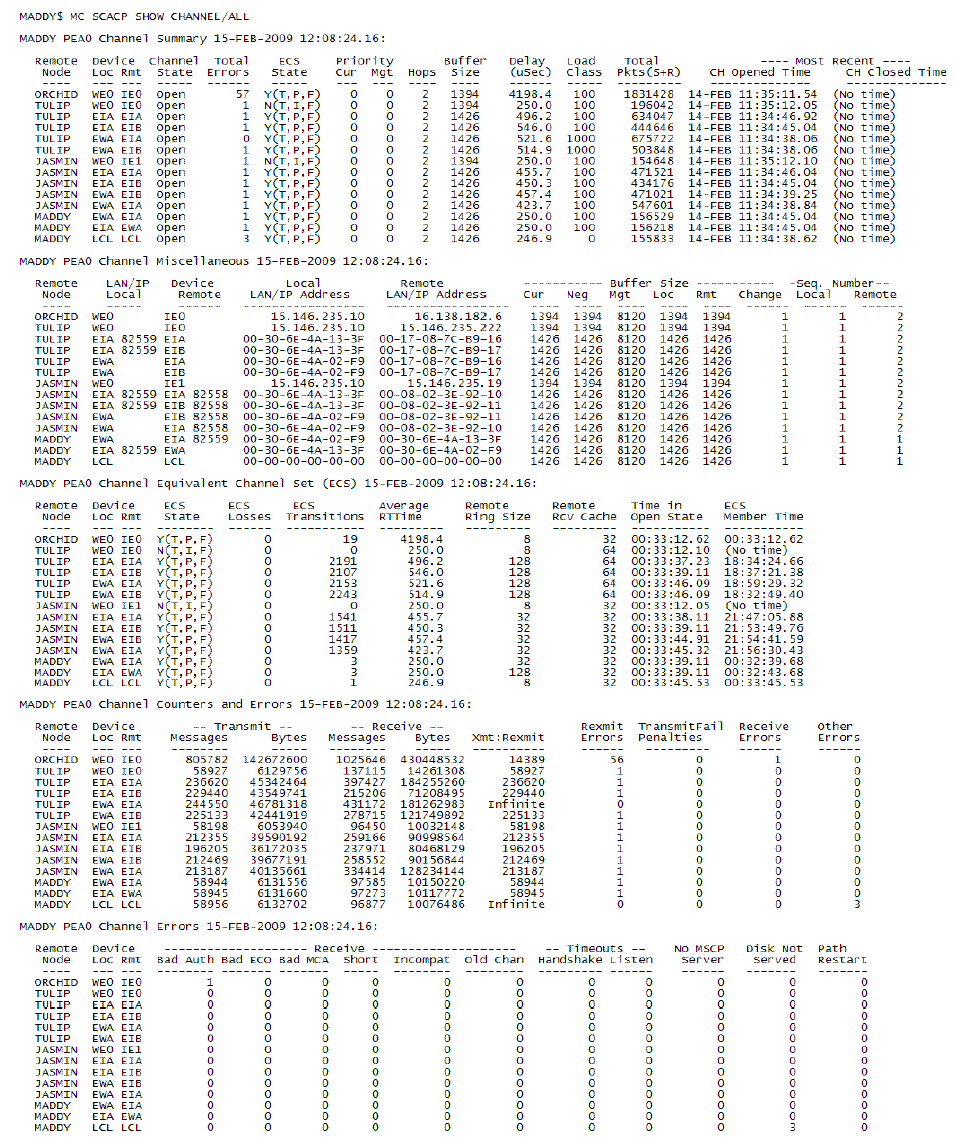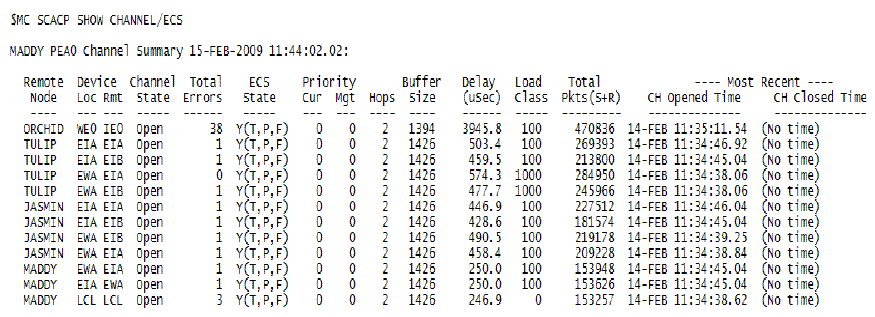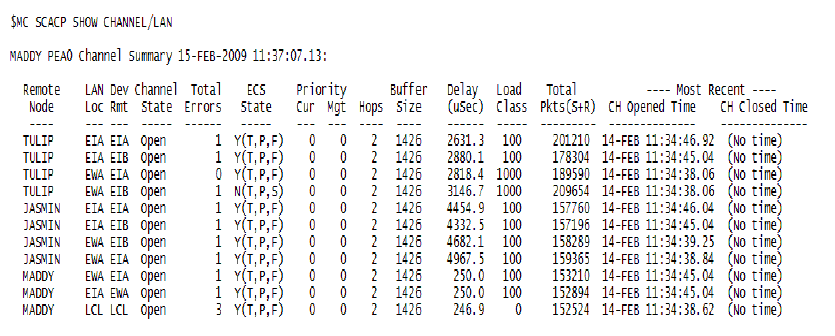HP OpenVMS Systems Documentation |
HP OpenVMS System Management Utilities Reference Manual
SET VC
Sets values for the virtual circuit management parameters (checksumming, compression, ECS delay threshold, transmit window size, and receive window size values). FormatSET VC nodename Parameter
Qualifiers
|
| #1 |
|---|
$RUN SYS$SYSTEM:SYSMAN
SYSMAN> SET ENV/NODE=LARRY
DO MC SCACP SET VC LARRY/WINDOW=TRANSMIT=16
SET ENV/NODE=CURLY
DO MC SCACP SET VC CURLY/WINDOW=TRANSMIT=16
SET ENV/NODE=LARRY
DO MC SCACP SET VC LARRY/WINDOW=RECEIVE=16
SET ENV/NODE=CURLY
DO MC SCACP SET VC CURLY/WINDOW=RECEIVE=16
EXIT
|
This example shows how to decrease window size. The transmit and receive window sizes are 32 on both nodes, and the commands decrease the window size for the VC between LARRY and CURLY. (You can enter the commands on either node.)
| #2 |
|---|
$RUN SYS$SYSTEM:SYSMAN
SYSMAN> SET ENV/NODE=LARRY
DO MC SCACP SET VC LARRY/WINDOW=RECEIVE=64
SET ENV/NODE=CURLY
DO MC SCACP SET VC CURLY/WINDOW=RECEIVE=64
SET ENV/NODE=LARRY
DO MC SCACP SET VC LARRY/WINDOW=TRANSMIT=64
SET ENV/NODE=CURLY
DO MC SCACP SET VC CURLY/WINDOW=TRANSMIT=64
EXIT
|
This example shows how to increase window size. The transmit and receive window sizes are 32 on both nodes, and the commands increase the window size for the VC between LARRY and CURLY. (You can enter the commands on either node.)
Displays PEdriver channel information for specific nodes. Each channel is a single NISCA communications path between a LAN device on a local system and a LAN device on a remote system.Use the SHOW CHANNEL command to display node names and local and remote device names.
SHOW CHANNEL nodename
nodename[,...]
Includes channels to specific nodes, which you can use wildcards to specify. Each node name can be accompanied by optional qualifiers to specify local and remote device names. If no local or remote device name is specified, all channels associated with the specified node name are included.
/ALL
Includes all channel data./COUNTERS
Includes channel counters data./ECS
/NOECS
Includes only channels that are (or are not) members of the ECS./EXCLUDE=(nodename[,...])
Excludes channels to specific nodes, which you can use wildcards to specify. Each node name can be accompanied by optional qualifiers to specify local and remote device names. If no local or remote device name is specified, all channels associated with the specified node are included./INTERVAL
For the /COUNTERS display, displays the changes to counters since the last SHOW command./IP
Includes the IP channel data./LAN
Includes the LAN channel data./LOCAL_DEVICE=(landevicename/IPinterfacename[,...])
Includes specific LAN devices that identify the local end of the channel; you can use wildcards to specify LAN devices.Use the SHOW LAN_DEVICE command to display device names.
/n
Displays the nth page. To select a particular page of a multipage display, specify the number of the page you want to display./OUTPUT=filespec
Creates the specified file and directs output to it./REMOTE_DEVICE=(landevicename/IPinterfacename[,...])
Includes specific LAN devices/IP interfaces that identify the remote end of the channel; you can use wildcards to specify LAN devices/IP interfaces.Use the SHOW LAN_DEVICE command to display device names.
/SDA
Includes channel data displayed in SDA format, with all the data collected in one display for one channel./SUMMARY
Includes channel summary data. This is the default if /ALL, /COUNTERS, and /SDA qualifiers are not specified.
| #1 |
|---|
SCACP> SHOW CHANNEL NODE20/LOCAL=EWA
|
The command in this example displays channel definition data for all nodes defined with local device EWA and any remote device and remote node name starting with NODE20.
| #2 |
|---|
SCACP> SHOW CHANNEL/COUNTERS/INTERVAL
SCACP> SPAWN WAIT 0:0:10
SCACP> SHOW CHANNEL/COUNTERS/INTERVAL
|
The first command in this example displays channel counters since the last SHOW command. The SPAWN command tells the DCL WAIT command to insert a 10-second delay. The second SHOW CHANNEL command displays counters after the 10-second period.
| #3 |
|---|
SCACP> SHOW CHANNEL/1/3
|
The command in this example displays the first and third pages of data for all channels. The first page contains Channel Summary data, and the third page contains Channel Equivalent Channel Set (ECS) data.
| #4 |
|---|
SCACP> SHOW CHANNEL/ALL
|
The following is a snapshot of the output for SHOW CHANNEL/ALL command.
Figure 21-1 Sample SHOW CHANNEL/ALL output

Table 21-2 describes the channel error data.
| Data | Description |
|---|---|
| Seq Retransmit |
Number of times a sequenced VC packet sent on this channel was
retransmitted, and the channel was penalized for the lost packet.
Note that the sequential retransmit is not necessarily a reflection of lost packet. It is possible that there can be a PE which could have triggered a retransmitted and results in a duplicate packet to be sent. This is reflected in the number of duplicate packets received in the remote node. The XMIT:REXMT ratio is also a measure of for how many transmitted packet, a packet was retransmitted. A very low value (less than 1000) reflects a possible network congestion. |
| LAN Transmit Failures | Number of times the local LAN device reported a failure to transmit a packet, and channel was penalized for the lost packet. |
| Restart Channel | Close or restart because channel control packet received indicating that the other end closed the channel and is restarting the channel handshake. |
| Channel Init Timeouts | Channel initialization handshake timeout. |
| Listen Timeouts | No packets of any kind, including HELLOs, were received in LISTEN_TIMEOUT seconds. |
| Bad Authorization Msg | Received a Channel Control (CC) packet with a bad authorization field. |
| Bad ECO CC Msg | Received a CC packet with an incompatible NISCA protocol ECO rev. field value. |
| Bad Multicast Msg | Received a bad multicast CC packet. |
| CC Short Packet | Received a CC packet that was short. |
| CC Incompatible | Received a CC packet that was incompatible with existing channels for this virtual circuit. |
| Rcv Old Channel | Received a packet from an old instance of a channel. |
| No MSCP Server | No MSCP server available to respond to a received channel control solicit service packet asking this node to boot serve another node. |
| Disk Not Served | Disk is not served by this system. |
| Buffer Size Change | Change in buffer size. |
| #5 |
|---|
SCACP> SHOW CHANNEL/ECS
|
The following is a snapshot of the output for SHOW CHANNEL/ECS command.
Figure 21-2 Sample SHOW CHANNEL/ECS output

ECS State Channel ECS Membership Information
OpenVMS uses multiple interfaces to communicate with any other node in order to do load balancing of communication. However, at a given time not all interfaces that link the remote node are used to transmit datagrams. OpenVMS maintains a set of equivalent channels ECS (Equivalent Channel Set) within a VC. These channels have approximately equivalent transmission quality at a given time. Only the channels within the ECS are used to transmit datagrams to the given node. "A" is the generic format above may be "Y" (Yes) or "N" (No) stating whether the channel is in the ECS or not. The remaining characters specify the quality of the channel as they are derived from the channel performance data. The characters are:
For more details about ECS, see the section NISCA Transport Protocol Channel Selection and Congestion Control in the HP OpenVMS Cluster Systems manual.
From OpenVMS Version 8.3 onwards, Topology change column from SHOW CHANNEL/FULL or /5 has been removed. This is because you must not consider this as an 'error' instead it is the count of failovers from one interconnect to the other interconnect. Whenever failover occurs to another interconnect the buffer size changes. Hence this topology change is counted under "Buffer SizeDecr" column in SHOW VC/FULL output. |
You can view the IP channel data summary by using the /IPCHANNEL qualifier, for example:
$ SHOW CHANNEL <nodename>/IPCHANNEL |
Figure 21-3 Sample SHOW CHANNEL/IP output

You can view the LAN channel data summary by using the /LANCHANNEL qualifier, for example:
$ SHOW CHANNEL/LANCHANNEL |
Figure 21-4 Sample SHOW CHANNEL/LANCHANNEL output

Displays SCA circuit information. You can further qualify each node name you specify with additional parameters to uniquely identify a single circuit.
SHOW CIRCUIT nodename
nodename[,...]
Includes specific circuits to individual nodes, which you can use wildcards to specify.
/EXCLUDE=(nodename[/PORT=portname[/RSTATION=n]][,...])
Allows you to exclude a specific circuit to a node. If multiple circuits to the same node exist, you can use the /PORT and /RSTATION qualifiers to uniquely identify the circuit./PORT=portname[/RSTATION=n]
If multiple circuits to the same node exist, you can use the /PORT and /RSTATION qualifiers to uniquely identify the circuit. You can use the /RSTATION qualifier only in conjunction with the /PORT qualifier.
SCACP>SHOW CIRCUIT
|
The command in this example displays all circuits to nodes over port PEA0.
Circuit data for CLUIO2 at 07-DEC 11:55:31.80 Node Port Priority Load Remote Remote Name Name Cur Mgt Class State Station Type -------- -------- ---- ---- -------- -------- ------- -------- LYNX03 PEA0 0 0 10 Open dc NI CLUIO1 PEA0 0 0 10 Open dd NI PRMMC2 PEA0 0 0 10 Open de NI RXBOT1 PIB0 5 0 48 Open 4 RF72 RXTOP1 PIB0 5 0 48 Open 1 RF73 RXTOP0 PIB0 5 0 48 Open 0 RF73 CLUIO1 PIB0 5 0 48 Open 7 N710 R4JC3I PIC0 5 0 48 Open 7 RF73 R4HLEK PIC0 5 0 48 Open 5 RF73 R4XEWM PIC0 5 0 48 Open 3 RF73 R4A1FN PIC0 5 0 48 Open 2 RF73 R4XSVE PIC0 5 0 48 Open 4 RF73 R4VLNI PIC0 5 0 48 Open 1 RF73
SCACP>SHOW CIRCUIT* /PORT=PEA0
|
This SHOW CIRCUIT command displays all circuits to all nodes.
Circuit data for CLUIO2 at 07-DEC 12:42:23.03 Node Port Priority Load Remote_Port Name Name State Cur Mgt Class Number Type -------- -------- -------- ---- ---- -------- ------- -------- LYNX03 PEA0 Open 0 0 100 dc NI CLUIO1 PEA0 Open 0 0 10 dd NI PRMMC2 PEA0 Open 0 0 10 de NI
Displays the PEdriver device IP interface data. Each device is an IP interface on the system, which can be used for NISCA communications.
SHOW IP_INTERFACE ipinterface
ipinterfacename[,...]
Includes one of more specific IP interface which you can use wildcards to specify.
- Use the /EXCLUDE qualifier to exclude IP interfaces.
- Use the SHOW IP_INTERFACE command to display device names.
/ALL
Includes all IP interface data./COUNTERS
Includes device counter data maintained by PEdriver and counters./EXCLUDE=(IP_INTERFACES[,...])
Excludes specific IP devices, which you can use wildcards to specify./INTERVAL
For the /COUNTERS display, displays the changes to counters since the last SHOW command./n
Displays the nth page. To select a particular page of a multipage display, specify the number of the page you want to display./OUTPUT=filespec
Creates the specified file and directs output to it./SDA
Includes IP interface data displayed in the SDA format with all the data collected in one display for an IP interface./SUMMARY
Includes IP interface summary data. This is the default if /ALL, /COUNTERS, and /SDA qualifiers are not specified.
SCACP>SHOW IP_INTERFACE/ALL
|
The following is a snapshot of the output for SHOW IP_INTERFACE/ALL command.
Figure 21-5 Sample SHOW IP_INTERFACE/ALL output

SCACP>SHOW IP_INTERFACE/COUNTERS
|
Displays IP interface counters.
Table 21-3 describes the IP/LAN device error data.
| Data | Description |
|---|---|
| Bad SCSSYSTEM ID | Received a packet with the wrong SCSSYSTEM ID in it. |
| MC Msgs Directed to TR Layer | Number of multicast packets directed to the NISCA Transport layer. |
| Short CC Messages Received | Number of packets received were short to contain a NISCA channel control header. |
| Short DX Messages Received | Number of packets received were short to contain a NISCA DX header for a LAN device. |
| CH Allocation Failures | Number of times the system failed to allocate memory for use as a channel structure in response to a packet received by this LAN device. |
| VC Allocation Failures | Number of times the system failed to allocate memory for use as a VC structure in response to a packet received by this LAN or IP device. |
| Wrong Port | Number of packets addressed to the wrong NISCA address (Invalid cluster group number). |
| Port Disabled | Number of packets discarded because the LAN or IP device was disabled. |
| H/W Transmit Errors | Number of local hardware transmit errors. |
| Hello Transmit Errors | Number of transmit errors during HELLOs. |
| Last Transmit Error Reason | Reason for last transmit error. |
| Time of Last Transmit Error | Time of last transmit error:date and time. |
For IP interfaces, the error count can increase for the following reasons. These errors will be displayed with any of the error codes.
| Previous | Next | Contents | Index |